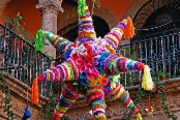Piñatas are a fun part of traditional Mexican festivities, whether it’s a birthday party or Cinco de Mayo. It's fun to see these brightly decorated candy-filled creations (and even more fun to take a whack at them) but piñatas actually have a long and fascinating history that spans the globe and different ancient cultures. Find out more about the history of the piñata!
 Pinatas are mostly considered a Mexican tradition in this day and age, but they have history all over the world!
Pinatas are mostly considered a Mexican tradition in this day and age, but they have history all over the world!
Chinese Cheer
Some people say that the idea of the piñata actually originated in China. When Marco Polo, a European explorer, first visited China he noticed that the people celebrated their lunar New Year with figures of cows, oxen and buffaloes decorate with colorful tissue paper. The figures would be filled with seeds and then pelted by revelers with mandarins, so when the seeds rained over the party it symbolised good crops and prosperity. The remains were then burned into ash for good luck.
Latin Craftin’
This idea traveled back to Europe with Marco Polo, back to Italy and eventually Spain as well and started appearing in the 14th Century. The word “pignatta” means “fragile pot”. Early piñatas were clay pots similar to ones that carry water, and in the 14th Century it was adopted as a way to celebrate Christian festivities, especially Lent.
In Spain the first day of Lent became “The Dance of the Piñata”, and as part of the festivities the plain clay pots became more and more decorated and colorful, often with ribbons and streamers and fringed paper.
 Pinatas have always traditionally been decorated with fringed colorful tissue paper
Pinatas have always traditionally been decorated with fringed colorful tissue paper
Aztec Allure
In the 16th Century the Spanish brought the custom of piñatas to the new world. They used the piñatas as a way of attracting the Mayan people to Christianity and converting them, but funnily enough both cultures already had similar traditions.
The native people of Mexico worshipped The Aztec God of War Huitzilopochtli by decorating a clay pot in vibrant colors, feathers and materials and placing it on a stick outside their temples at the year’s end. The Mayans loved public festivities, so they would cover their eyes and try to hit the decorated pot with a stick. The pot was often filled with jewels and treasures! The treasures would then fall outside the temple as an offering to the god of war.
 The Ancient Aztecs worshipped the God of War using an early version of a pinata
The Ancient Aztecs worshipped the God of War using an early version of a pinata
Have Your Say
Do you like piñatas? Have you ever made one? Let us know in the comments section below!
Related Stories

































